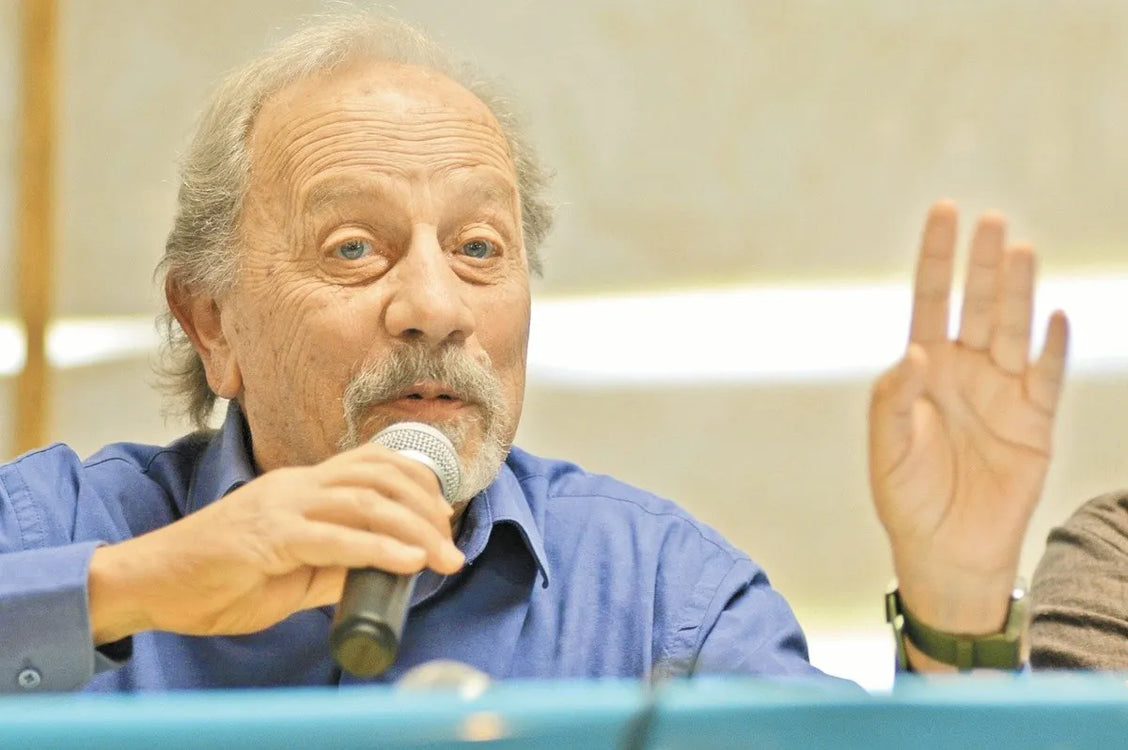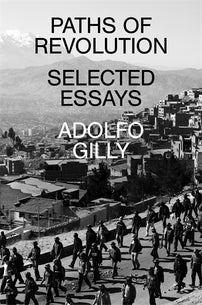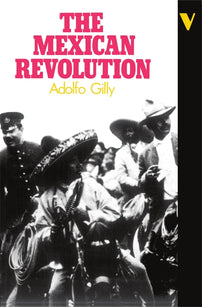Introduction to Paths of Revolution
The great historian Adolfo Gilly passed away on July 4, 2023. In his honor, we are publishing an extract of Tony Wood's introduction to his book, Paths of Revolution.

Adolfo Gilly lived many lives: leftist militant, journalist, political prisoner, public intellectual, historian. At times these roles overlapped, at others they remained distinct. But in each of them, he was a direct observer of key events in Latin American history, from the Cuban Missile Crisis to Central America’s guerrilla movements of the 1960s, and from Mexico’s Zapatista uprising of 1994 to the indigenous and popular mobilizations that swept Evo Morales to power in Bolivia in the early 2000s. In that sense, until his death in July 2023, Gilly provided a living link—across the tumult of several decades—between the post-war generations of the Latin American left and the radical upsurges accompanying the ‘Pink Tide.’
Born Adolfo Malvagni Gilly in Buenos Aires in 1928, he would eventually adopt his mother’s surname. His father, Atilio Malvagni, was a former lieutenant in the Argentine navy and a lawyer. His mother, Delfa Esther Gilly, was from a family of French-descended landowners. Both parents transmitted a love of culture to Adolfo and his two sisters, Delfa and Graciela, taking them to operas and concerts at the Teatro Colón and encouraging them to read widely; Gilly recalled devouring works by Cervantes, Dante, Alexandre Dumas, and Jules Verne in his father’s library. Fittingly, one of his earliest jobs kept him close to the world of print: working at a printshop, he corrected proofs and set type with a Linotype press.
Gilly came to political consciousness in the 1940s. In 1946, the same year Juan Domingo Perón rose to power on the back of mass support from the Argentine working classes, Gilly joined the Juventud Socialista, the youth wing of the Argentine Socialist Party. But the following year, he left the party after the leadership shut down the student newspaper Rebeldía for its ‘leftism’. He and others formed the short-lived Workers’ Revolutionary Movement (Movimiento Obrero Revolucionario, MOR) before gravitating, at the end of the 1940s, towards the Trotskyist Fourth International (FI).
His militancy in the ranks of the Fourth International—his nom de guerre was “Lucero”—would shape the rest of his personal and political trajectory, sending him from Buenos Aires to the Bolivian altiplano and from revolutionary Havana to the jungles of Guatemala. He aligned himself with the current within the FI led by Homero Cristalli, better known under his pseudonym “J. Posadas.” Posadas later gained notoriety for his domineering manner, his sectarian manoeuvring, and his eccentric views (for example on UFOs). But it was Posadas’s reading of Latin American realities that appealed to Gilly. As he recalled in a 2010 interview, other parts of the Argentine left tended to either see Perón as an agent of British imperialism or as “some sort of snake-charmer with a flute” who had bewitched the masses. Posadas, by contrast, had argued that “Peronism was the specific form that the organization of the working class took in our country, and we had to understand it… the workers may have been following a charismatic leader, but they did so for their own reasons.” This early impulse to interpret popular politics on its own terms would recur throughout Gilly’s work.
It was the Latin America Bureau of the FI, controlled by Posadas, that sent Gilly to Bolivia in 1956, in the heady period after the country’s National Revolution of 1952. Trotskyism occupied an unusually prominent place in the Bolivian political landscape compared to the rest of Latin America, with the Revolutionary Workers’ Party (Partido Obrero Revolucionario, POR) acquiring a mass working-class following and exerting a strong influence on the powerful miners’ unions. The four years Gilly spent there introduced him to a world of Andean indigenous traditions and peasant politics that was entirely new to him. It was also in Bolivia that he began writing for the Uruguayan weekly Marcha, for whom he would continue to produce reportage thereafter.
Gilly spent the years 1960–62 in Europe, working as a representative of the FI’s Secretariat and based mostly in Italy. This was a time of significant shifts in the nature of industrial labour. The “hot autumn” of 1969 was still a few years off, but Gilly recalled seeing the beginnings of the workers’ councils and the “autonomist” movement. It was also a contentious time within the FI, as strategic differences over the relative importance of proletarian revolution in Europe versus national and anti-colonial revolutions in the “Third World” led to an internal split. The two currents were led, respectively, by Ernest Mandel and Michel Pablo. Mandel ultimately remained at the head of the FI, but Gilly’s sympathies with the “Pabloite” view clearly informed much of his later work: “as I see it now,” he observed to me in 2010, “it is the revolt of the colonial world that gives the twentieth century its meaning.”
The Cuban Revolution was a transformative event for the Latin American left as a whole, seeming to provide a new model for a radical convergence between anti-imperialism and socialism. Sent to the island by the FI in 1962, Gilly liaised there between the Latin America Bureau and Cuba’s Trotskyist currents, a marginal but vocal presence within the broader Cuban revolutionary coalition—nestling awkwardly alongside the Stalinist Popular Socialist Party (Partido Socialista Popular, PSP). Gilly’s reports from the island amid the Cuban Missile Crisis, published in the New York-based Monthly Review, convey his enthusiasm for the revolution’s early radical thrust and its capacity to mobilize the populace. But he also drew attention to the growing strength of bureaucratic tendencies. Trotskyist criticisms along these lines drew the anger of Fidel Castro, and in October 1963, amid a wider crackdown on leftist dissenters, Gilly was arrested and expelled from Cuba.
Between 1964 and 1966, Gilly was integrally involved in one of Latin American Trotskyism’s closest engagements with a guerrilla movement, the Guatemalan Revolutionary Movement November 13 (Movimiento Revolucionario 13 de Noviembre, MR-13). Formed in 1960 by progressive Guatemalan army officers who opposed the dictatorship of Miguel Ydígoras—most notably its decision to allow the US to train anti-Castro fighters on Guatemalan soil—the MR-13 took a decisive leftward turn in late 1963, adopting socialism as its formal goal and aligning itself with the Fourth International. Gilly served as the liaison between the guerrillas and the FI while also producing reportage on the MR-13’s struggle. The note of optimism running through his accounts of the guerrilla struggle in Guatemala soon proved tragically unfounded: in April 1966, several of Gilly’s comrades were killed or disappeared when the Guatemalan government cracked down on the MR-13.
Gilly fled Guatemala for Mexico in April 1966. Barely two weeks after his arrival, he was arrested and jailed along with several comrades. He spent the next six years in Lecumberri Prison, the “Black Palace” that now serves as Mexico’s national archive. (Back in the late 1960s, Gilly mischievously noted, “It was me who had been archived.”) In the wake of Mexico’s 1968, when government forces gunned down protestors in Tlatelolco, many more political prisoners joined Gilly and his comrades in Lecumberri. He recalled the atmosphere among the “politicals” in N-Block as being “almost like a monastery,” and he read widely and voraciously: the entire Marx–Engels correspondence, Hegel, the poetry of Octavio Paz, among countless others. But the project that consumed much of his time was his landmark history of the Mexican Revolution.
La revolución interrumpida. (The Interrupted Revolution; translated into English in 1983 as The Mexican Revolution) appeared in 1971, while Gilly was still in prison. It remains unrivalled as a single-volume social history of the Mexican Revolution. Inspired by the example of Trotsky’s History of the Russian Revolution, which he re-read in prison, Gilly sought to establish, as he put it, “the inner impetus behind the movements of the masses—not who won which battle, but what the hell all these people wanted.” The book lucidly represented the maelstrom of Mexico’s revolutionary years as a clash between contending social forces, driven by conflicting aspirations and visions of the country’s future. It also offered a counter to official narratives, in which, as Gilly put it, “everyone was a good guy, and it was totally unclear why they all ended up killing each other.” At the same time, it ran against the tide of revisionist studies that had begun to appear in the wake of 1968, and that sought to undermine the revolution as the founding myth of the system established by the Institutional Revolutionary Party (Partido Revolucionario Institucional, PRI). Gilly recuperated the original social impetus behind the Revolution, the popular struggles that had been “interrupted,” as per the book’s title, without thereby legitimating the one-party state that had been its outcome.
Released from prison in March 1972, he spent four years in Europe, again working for the FI but growing increasingly disillusioned with the Posadists. “The atmosphere was conspiratorial, sectarian and rigid,” he recalled: “I had felt much freer in prison.” He returned to Mexico in 1976 and settled there for good, gaining Mexican citizenship in 1982. From 1979 onwards he taught in the Department of Political and Social Sciences at the National Autonomous University of Mexico (Universidad Nacional Autónoma de México), and established himself as a prominent voice on the country’s left, intervening in debates both as a scholar and as a public intellectual. The scale and scope of Gilly’s work increased as he addressed an ever-wider variety of themes and ranged further back into Mexico’s past to explain its present.
In 1994, the Zapatista Army of National Liberation (Ejército Zapatista de Liberación Nacional, EZLN) seized the city of San Cristóbal in Chiapas and launched an insurgency that would electrify Mexican politics. Gilly was a prominent early supporter, meeting with the EZLN in May 1994 and writing a study of the Chiapas rebellion. He sought to bring out the deep legacies of indigenous oppression that gave rise to the rebellion. His thinking was informed not only by the work of Mexican historians and anthropologists such as Guillermo Bonfil Batalla, but also by lessons drawn from a broader historiography, especially work by the Subaltern Studies school on resistance to British colonial rule in India. The same combination of historical depth and comparative sweep also shaped his assessment of the indigenous and popular revolts in Bolivia in the early 2000s. As Gilly argued, the mobilizations that eventually took Evo Morales to power were propelled both by immediate reactions against neoliberal rule and longer traditions of collective resistance.
Much of Gilly’s more recent work was historical in nature, the product of a distinguished scholarly career that saw him invited for stints as visiting professor at Chicago, Columbia, NYU, Stanford, Yale, and the National Humanities Center (twice). In 2013 he wrote Cada quien morirá por su lado, a monograph on the “Ten Tragic Days” of February 1913, which culminated in the deposition and killing of the Mexican president, Francisco Madero, by US-supported military dictator Victoriano Huerta. In 2019, his magisterial biographical study of the Mexican revolutionary general Felipe Angeles was published to widespread acclaim.
Yet historical scholarship represented only one facet of Gilly’s activities. Art and literature were a constant feature ever since his teenage encounters with the work of the Surrealist André Breton and the novels of Herman Melville, among many others. In numerous essay collections he wrote about an array of figures whose work impacted him, from Argentine poets Alejandra Pizarnik and Juan Gelman to the eighteenth-century Italian artist Giovanni Battista Piranesi. In theoretical essays, he engaged with thinkers from a range of times and places, most notably in his 2006 collection Historia a contrapelo (History against the Grain), which drew on Antonio Gramsci, Walter Benjamin, Karl Polanyi, E. P. Thompson, Guillermo Bonfil Batalla, and Ranajit Guha as keys for understanding the history of Mexico and of Latin America more broadly.
An observer of radical mobilizations from the 1950s to the present, in his writings Gilly sought to trace their lineages back through decades or even centuries, identifying what was genuinely new while at the same time pointing to deep continuities—and always with an eye on the substance of popular politics, on what drives people to action under different forms of domination. As well as testifying to Gilly’s singular personality and lifelong political and intellectual engagement, his work is also an outstanding example of the integrity—in both senses of the word—of Latin America’s revolutionary traditions.
[book-strip index="1"]

